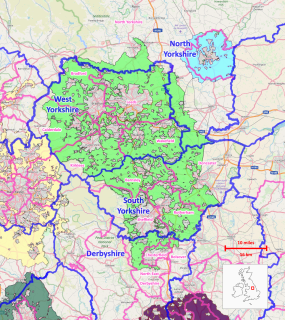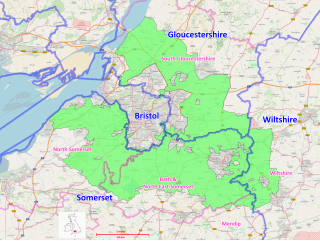
The Dominican Republic has a close relationship with the United States and with the other states of the Inter-American system. It has accredited diplomatic missions in most Western Hemisphere countries and in principal European capitals.
An urban growth boundary, or UGB, is a regional boundary, set in an attempt to control urban sprawl by, in its simplest form, mandating that the area inside the boundary be used for urban development and the area outside be preserved in its natural state or used for agriculture. Legislating for an "urban growth boundary" is one way, among many others, of managing the major challenges posed by unplanned urban growth and the encroachment of cities upon agricultural and rural land.

Makati,, officially the City of Makati,, or simply known as Makati City, is a 1st class highly urbanized city in Metro Manila, Philippines.

The Boise River Greenbelt is a recreational and alternate transportation trail along the banks of the Boise River through Boise, Idaho, United States. The Boise Greenbelt is more of a greenway than a green belt since its character is linear. It extends more than 20 miles (32 km) beginning at Lucky Peak Dam in the east to a short distance beyond Eagle Road in the west in Eagle, Idaho. Taking into account both sides of the river and other parallel trails and spurs, the total Greenbelt trail system measures more than 30 miles (48 km).

A greenway is "a strip of undeveloped land near an urban area, set aside for recreational use or environmental protection". However, the term can in fact include "a scenic road" and though many are in urban areas, there are some rural greenways, as for example the Monadnock-Sunapee Greenway, a hiking trail in southern New Hampshire.

Ayala Avenue is a major thoroughfare in Makati, Philippines. It is one of the busiest roads in Metro Manila, crossing through the heart of the Makati Central Business District. Part of Ayala Avenue forms Circumferential Road 3. Because of the many businesses located along the avenue, Ayala Avenue is nicknamed the Wall Street of the Philippines. It is also a major link between Epifanio de los Santos Avenue (EDSA) and Metropolitan Avenue.

The Pan-Philippine Highway, also known as the Maharlika Highway is a 3,517-kilometer (2,185 mi) network of roads, bridges, and ferry services that connect the islands of Luzon, Samar, Leyte, and Mindanao in the Philippines, serving as the country's principal transport backbone. It is the longest highway in the Philippines that forms the country's north–south backbone component of the National Route 1 (N1) of the Philippine highway network. The entire highway is designated as Asian Highway 26 (AH26) of the Asian Highway Network.

Greenbelt is a shopping mall located at Ayala Center, Makati, Metro Manila, Philippines which is just near Glorietta and SM Makati. It is owned by Ayala Malls, a real-estate subsidiary of Ayala Land, which is an affiliate of Ayala Corporation. It opened in the 1988 and is one of Ayala Corporation's flagship projects. The mall offers a mix of high-end retail shops, restaurants, amenities, leisure and entertainment. Currently, the mall has five sections: two enclosed areas, two buildings with open-air shopping areas, and Greenbelt 5, which opened in 2007.

An open space reserve is an area of protected or conserved land or water on which development is indefinitely set aside.

Tourism is an important industry in Metro Manila, Philippines. In 2012, the city and region welcomed 974,379 overnight visitors. As the main gateway to the Philippines' many destinations, the city is visited by the majority of international tourists to the country registering a total of 3,139,756 arrivals in 2012. Global Blue ranked Manila eleventh in its "Best Shopping Destinations" in Asia. The city is ranked tenth in MasterCard's global top 20 fastest growing cities for international visitors from 2009-2013.
Numerous events and festivals are held annually in Metro Manila. They include:

The Gil Puyat Avenue, formerly and still referred to as Buendia Avenue, is a major arterial thoroughfare which travels east–west through the cities of Makati and Pasay in western Metro Manila, Philippines. It is one of the busiest avenues in Metro Manila linking the Makati Central Business District with the rest of the metropolis. Its western end begins at Roxas Boulevard and continues through San Isidro District, Pasay until intersecting with Taft Avenue. Past the intersection with the elevated Gil Puyat LRT Station, the road runs through Tramo Street and Barangay Palanan in Makati. East of Osmeña Highway, Gil Puyat intersects with the busy streets of the Central Business District before finally reaching its terminus at Epifanio de los Santos Avenue (EDSA).

Makati Avenue is a major commercial thoroughfare in Makati, Metro Manila, Philippines. It forms the eastern border of Ayala Triangle and is one of the three main avenues of the Makati Central Business District. The avenue runs in a somewhat north-south diagonal direction almost parallel with Epifanio de los Santos Avenue (EDSA). It passes through two distinct neighborhoods of the city: the Makati CBD and the old Makati Población. At its northern end lies the older part of Makati starting from the Makati-Mandaluyong Bridge and J.P. Rizal Avenue. It continues through Población to Gil Puyat Avenue, marking the southern edge of the old district. South of Gil Puyat onto the CBD, the avenue becomes more commercial and upscale. The shopping hub of Ayala Center and Arnaiz Avenue lie at its southern end.

The Makati Central Business District, also known as the Makati CBD, is the leading financial and central business district in the Philippines located at the heart of Makati in Metro Manila. It is politically known as "Central Cluster" in the West District of Makati. It is different from the civic center of Makati known as "Makati Poblacion" which is situated at the north-east portion of the district. It is bounded by EDSA, Gil Puyat Avenue, Arnaiz Avenue, and Chino Roces Avenue. The whole district occupies barangays of San Antonio, San Lorenzo, Bel-Air, and Urdaneta.

The South and West Yorkshire Green Belt is a green belt environmental and planning policy that regulates the rural space within the Yorkshire and the Humber region of England. It is contained within the counties of South Yorkshire and West Yorkshire, North Yorkshire, and Derbyshire. Essentially, its primary function is to more rigorously manage development around the cities, towns and villages in the large West Yorkshire Urban Area-, the Sheffield urban area and surrounding towns of Barnsley, Doncaster, Rotherham, as well as other nearby locations, in order to discourage urban sprawl and further convergence between these. It is managed by local planning authorities on guidance from central government.

The Avon Green Belt, also known as the Bristol and Bath Green Belt, is a non-statutory green belt environmental and planning policy that regulates urban expansion and development in the countryside surrounding the cities of Bristol and Bath in the South West region of England. It covers areas in Bristol, South Gloucestershire, North Somerset, Bath and North East Somerset, Mendip, and Wiltshire. Essentially, the function of the green belt is to limit urban sprawl and maintain the open character of areas around the Bristol and Bath built up areas, and nearby towns and villages. The policy is implemented by local planning authorities on the basis of guidance from central government.
























